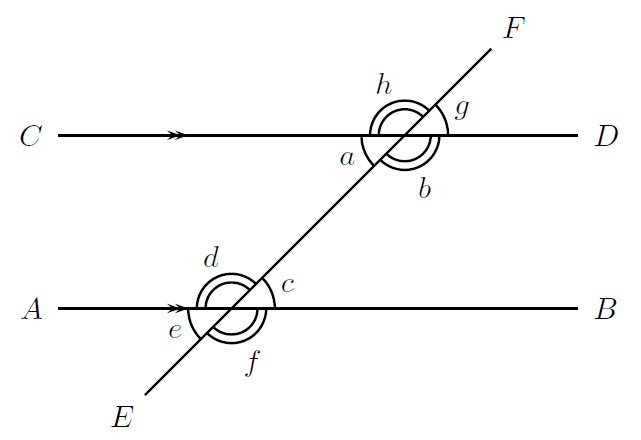| << Chapter < Page | Chapter >> Page > |

Once angles can be measured, they can then be compared. For example, all right angles are 90 , therefore all right angles are equal and an obtuse angle will always be larger than an acute angle.
The following video summarizes what you have learnt so far about angles.
Khan academy video on angles - 1
In
[link] , straight lines
and
intersect at point X, forming four angles:
or

The table summarises the special angle pairs that result.
| Special Angle | Property | Example |
| adjacent angles | share a common vertex and a common side | , , , |
| linear pair (adjacent angles on a straight line) | adjacent angles formed by two intersecting straight lines that by definition add to 180 | ; ; ; |
| opposite angles | angles formed by two intersecting straight lines that share a vertex but do not share any sides | ; |
| supplementary angles | two angles whose sum is 180 | |
| complementary angles | two angles whose sum is 90 |
The following video summarises what you have learnt so far
Khan academy video on angles - 2
Two lines intersect if they cross each other at a point. For example, at a traffic intersection two or more streets intersect; the middle of the intersection is the common point between the streets.
Parallel lines are lines that never intersect. For example the tracks of a railway line are parallel (for convenience, sometimes mathematicians say they intersect at 'a point at infinity', i.e. an infinite distance away). We wouldn't want the tracks to intersect after as that would be catastrophic for the train!

All these lines are parallel to each other. Notice the pair of arrow symbols for parallel.
A section of the Australian National Railways Trans-Australian line is perhaps one of the longest pairs of man-made parallel lines.
Longest Railroad Straight (Source: www.guinnessworldrecords.com) The Australian National Railways Trans-Australian line over the Nullarbor Plain, is 478 km (297 miles) dead straight, from Mile 496, between Nurina and Loongana, Western Australia, to Mile 793, between Ooldea and Watson, South Australia.
A transversal of two or more lines is a line that intersects these lines. For example in [link] , and are two parallel lines and is a transversal. We say . The properties of the angles formed by these intersecting lines are summarised in the table below.

| Name of angle | Definition | Examples | Notes |
| interior angles | the angles that lie inside the parallel lines | in [link] , , and are interior angles | the word interior means inside |
| adjacent angles | the angles share a common vertex point and line | in [link] ( , ) are adjacent and so are ( , ); ( , ); ( , ) | |
| exterior angles | the angles that lie outside the parallel lines | in [link] , , and are exterior angles | the word exterior means outside |
| alternate interior angles | the interior angles that lie on opposite sides of the transversal | in [link] ( ) and ( , ) are pairs of alternate interior angles, , |
 |
| co-interior angles on the same side | co-interior angles that lie on the same side of the transversal | in [link] ( , ) and ( , ) are interior angles on the same side. , |
 |
| corresponding angles | the angles on the same side of the transversal and the same side of the parallel lines | in [link] , , and are pairs of corresponding angles. , , , |
 |
The following video summarises what you have learnt so far
Khan academy video on angles - 3
Find all the unknown angles in the following figure:

Determine if there are any parallel lines in the following figure:








The following video shows some problems with their solutions
Khan academy video on angles - 4

Notification Switch
Would you like to follow the 'Siyavula textbooks: grade 10 maths [caps]' conversation and receive update notifications?